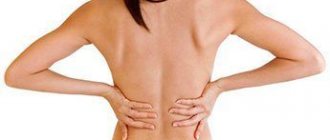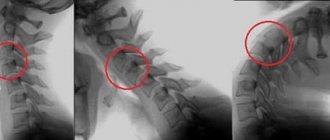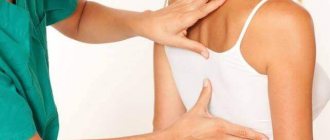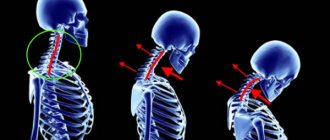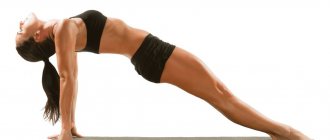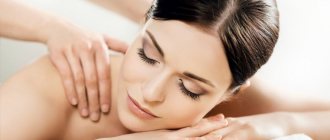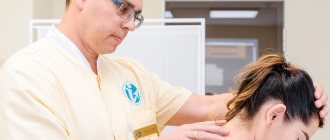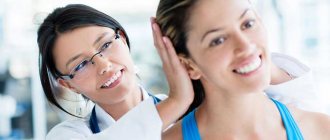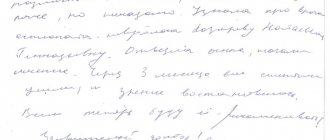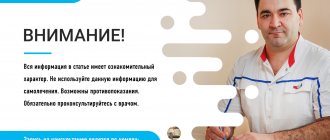Cervical scoliosis is one of the most common pathologies, affecting more than 40% of the population. Scoliosis of the cervical spine most often affects representatives of the fair half of humanity and is characterized not only by pain, but also by possible disturbances in the blood supply to the brain, which is very dangerous.
This occurs due to compression of the vertebral artery, which supplies about a quarter of the brain structures.
At CELT you can get advice from a neurosurgeon.
- Initial consultation – 3,000
- Repeated consultation – 2,000
Make an appointment
What is scoliosis of the cervical spine
The cervical spine is equipped with a natural C-shaped curve, which follows the lumbar spine, but only in the opposite direction . It has an exceptional feature related to ensuring head mobility. This is achieved due to the special design and method of attaching the upper vertebrae.
Cervical scoliosis is an unnatural curvature of the upper sector along the right-left axis.
Brief history of the disease
The formation of pathology begins in most cases at the age of ten , and in girls it occurs twice as often as in boys. The disease progresses slowly and is quite difficult to notice in the early stages.
In most cases, cervical scoliosis is idiopathic , that is, it occurs on its own, for no apparent reason. They are often based on genetic factors or a hereditary predisposition to this disease. Knowing this, you can avoid this pathology by creating the right conditions for the child’s development.
Cervical scoliosis is an idiopathic phenomenon, as it occurs without cause
In other cases, the appearance of the disease may be associated with impaired fetal development, when vertebrae are not formed correctly in the prenatal period. And in childhood this may be due to a violation of the coordination of muscle and bone development.
The severity of the disease depends on its origin, how timely the diagnosis was, age, concomitant pathologies from other organs, the rate of progression of the disease and other factors. The treatment tactics used are also associated with them.
Classification
Cervical scoliosis according to etiology is divided into the following types::
- congenital
- idiopathic
- dysplastic
- static
- neurogenic.
In first place in terms of frequency of occurrence is idiopathic scoliosis , which was mentioned earlier. Congenital scoliosis is intrauterine developmental pathology. In many cases, the disease progresses during adolescence, when the spine grows at an accelerated rate. The additional load on the affected vertebrae gives impetus to this process.
Static scoliosis is associated with a systematic uneven distribution of load on a certain part of the spine. This happens in professional activities, when the same type of movements are forced to be repeated.
With dysplastic scoliosis, there is a disturbance in the metabolism and blood supply to the tissues of the spine. This pathology manifests itself already at the age of three.
Neuromuscular scoliosis can be associated with spinal injuries, traumatic brain injuries, neurological or muscular dysfunctions.
It accompanies the course of diseases such as polio, cerebral palsy, and is observed with damage to the spinal cord and muscles. According to the degree of curvature, cervical scoliosis is classified as follows :
| Degree | Deformation angle |
| 1st degree | up to 10 degrees |
| 2nd degree | up to 25 degrees |
| 3rd degree | curvature up to 40 degrees |
| 4th degree | more than 40 degrees |
Prevalence and significance
In most cases, the development of scoliosis occurs in children over 10 years of age ; girls are affected twice as often as boys, and adult women are three times more likely than men. Although this spinal pathology occurs in more than a third of the adult population, cervical scoliosis is not the dominant location for it.
It is much less common than deformation of the thoracic portion of the supporting system. After all, the cervical region includes 7 vertebrae, and the thoracic region - 12; they are also larger than the cervical bones.
Contraindications to the use of osteopathy
Like any technique, osteopathy has a number of contraindications, the use of which methods is prohibited. These include:
- the presence of an inflammatory process in the body;
- installed implants or other parts (spirals, wires);
- renal failure;
- discharge in women;
- acute infectious diseases;
- diseases of the cardiovascular or circulatory system;
- bleeding.
If any of the listed manifestations are present, the use of osteopathic techniques is not recommended due to possible harm to the body due to incorrect identification of the source of the disorder.
Risk factors and causes
Risk factors for the occurrence and progression of cervical scoliosis are divided into the following groups:
| By gender | According to the age | According to medical indicators | Occupational hazards |
| A slight degree of curvature is observed at the age of ten, approximately equally in both boys and girls. It progresses further in girls 10 times more often than in boys. In women, the incidence of scoliosis is influenced by menstruation, which prolongs bone growth and thereby increases the risk of bone deformation. | In adolescence, the first degree of curvature is observed in 2-4%. But it progresses to the second or higher degree in only 0.5% of these children. | The risk group includes people suffering from arthritis, muscular dystrophy, polio, and cerebral palsy. Organ transplantation in childhood is also an increased risk. | For young athletes, the chance of getting sick is 2-24%. The leaders among them are figure skaters, dancers, tennis players, skiers, javelin throwers, gymnasts and swimmers. |
To avoid the development of cervical scoliosis, pay attention to the possible causes of the pathology. However, provoking factors for scoliosis are:
- lack of movement and muscle weakness.
- incorrect posture.
- calcium deficiency in the body.
- overweight.
- injuries, burns.
- genetic diseases.
Doctors put forward several theories about the occurrence of high (cervical) scoliosis:
- Dysfunction of the endocrine glands . During hormonal changes during adolescence, a disruption in its background affects the strength of the vertebrae.
- Imbalance in the development of the muscular and bone apparatus , when, with the rapid growth dynamics of the child, the muscles are not able to fully support the spine.
- The dysplastic theory associates changes in bones with insufficient nutrition and blood supply in childhood and adolescence.
- Neurogenic factors are the influence of pathologies of the nervous system on spinal deformity.
Video: “Anatomy of the spine”
Consequences
The consequences of the development of high scoliosis are different with its different degrees:
- A slight curvature, noticeable only on an x-ray, may not interfere with normal life.
- In the second degree, the asymmetry of the shoulder girdle is already noticeable. Therapy is needed here, since without its help the pathology progresses quickly.
- In the third degree of the disease, the deformity is clearly visible; in this case, wearing a fixation corset or surgical intervention is often required.
- With the most severe degree of pathology, conservative treatment methods are powerless; many organs and systems of the body are involved in the process.
Causes of the disease
Doctors are inclined to believe that scoliosis does not have obvious causes, but is conventionally divided into acquired and congenital. The first type is typical for acquired spinal injuries, and the second can be obtained from birth injuries.
The list of disorders in the body that provoke cervical scoliosis includes:
- poor development of the musculo-ligamentous cervical apparatus with accelerated skeletal growth;
- violation of skeletal ossification due to poor metabolism;
- pathological changes in the delivery of nutrients and oxygen to the spine;
- disruption of the nervous system in the muscles of the neck and shoulder girdle.
Symptoms and diagnostic methods
With cervical scoliosis, there is an asymmetrical position of the head , its tilt to the right or left due to the displacement of the cervical vertebrae. In this case, one ear is higher than the other. High scoliosis is usually painless. The appearance of pain is the result of the connection of concomitant diseases. This is usually due to pinching of nerve fibers, as happens, for example, with an intervertebral hernia.
At the initial stage of scoliosis, even these signs are barely noticeable. But at grade 2-3, the following symptoms already appear :
- Radiculitis is inflammation of the nerve roots due to displacement of the intervertebral discs. Pain in the neck, upper chest and back of the head. In addition to them, there is numbness of the hand on the side of the curvature.
- Osteochondrosis and decreased height of the vertebral discs, calcium salt deposits.
- Increasing pain in the shoulders and back when inhaling and bending.
- Morning pain in the back of the head, decreased performance of the neck muscles, which makes it impossible to bend and straighten the neck.
- Dizziness, appearance of spots in the eyes, tinnitus.
- Due to pinching of the vertebral artery, a feeling of tension and heaviness appears in the head.
- Deterioration of blood supply to the brain, which causes hearing and vision to deteriorate, the tongue to go numb and a decrease in taste sensations.
- Pain in the heart area.
Scoliosis can be detected by examination when the patient bends forward with his arms down . In this position, the line of the vertebrae and its curvature are visible. An x-ray examination is also prescribed. By drawing two lines parallel to the neutral vertebrae on the resulting image, you can determine the angle of curvature of the vertebrae. In addition, an MRI of the cervical spine is performed.
Physiotherapy
Exercise therapy is a set of exercises that help strengthen the muscle corset and correct posture. Therapeutic exercise is considered a priority method for the treatment of cervical scoliosis, the result of which depends on the type of disease, form ( C, S and Z ), the degree of its development ( I-IV ) and the age of the patient.
In the first stages, the prognosis for cure is much higher than in advanced cases in the third and fourth stages.
Correction of posture occurs faster at the age when the child’s skeleton is actively developing, i.e. from 10 to 15 years. However, even at an older age, much depends on the wishes of the patient himself. Regular physical exercise and a strong desire to achieve results will definitely lead to a positive result.
Exercise therapy pursues various goals:
- eliminates imbalance of muscles and ligaments,
- relieves the load on the spinal column,
- strengthens back muscles,
- corrects posture,
- heals the entire body.
Exercises for cervical scoliosis should begin with a warm-up:
- nodding your head,
- bending to the sides,
- head turns,
- shoulder lift and rotation,
- raising hands,
- tilts.
The most effective for cervical scoliosis are static exercises; they can also be performed during an exacerbation. In this case, the main action that is carried out by the muscles of the neck is pressure and resistance, when the hand presses on the head from the right or left, and the head resists this. Pressure-resistance is also applied to the back of the head or forehead.
Please note: the main rule of the exercises should be performed at a slow pace, smoothly, without sudden movements, alternating tension with relaxation. During exacerbations, all exercises except static ones are contraindicated.
After warming up, you can proceed to the main complex:
- Lying on your stomach, raise your head and bend your spine
- With your hands on the floor, lift your body and bend over.
- Lying on the floor, simultaneously raise your arms up, and while exhaling, lower them.
- In conclusion, roll to the side, lying on your back, clasping your bent knees with your hands.
- In a sitting position - circular movements in the belt, hanging on the crossbar.
Treatment
Did you know that...
Next fact
When treating lateral curvature of the neck, the following methods are used : physical therapy, osteopathy - restoration of normal blood circulation with the help of hands to improve the functioning of the spine, drug treatment, massage and manual therapy, traditional medicine.
Drugs
Drug therapy is used for scoliosis to reduce the symptoms of the disease and prevent complications. To support bone tissue, calcium supplements are used together with vitamin D3.
To relieve radiculitis, non-steroidal anti-inflammatory drugs Diclofenac, Ibuprofen and others are prescribed. To relieve pain and reduce inflammation with concomitant osteochondrosis, chondroprotective gel agents Chondroitin, Chondroxide and others are used.
Surgical
Surgical treatment has the following goals::
- Reduction of vertebral asymmetry by resection of a segment of the intervertebral disc and plates from the convex side.
- Stabilization of bone deformity using a bone graft.
- Corrective intervention to stabilize the degree of curvature.
- Cosmetic correction of a pathological defect.
Exercise therapy, massage
In the morning, during a prolonged static state or during similar movements, they practice turning the head in different directions , alternately tilting it towards the shoulders and down. Also useful are exercises for stretching the neck with your chin and ears reaching your shoulders, and “looking” behind your back.
Some exercises from exercise therapy for the neck
They do exercises to rotate the shoulder joints and breathing exercises. All parts of the spine are brought into motion, working on the back, bending the legs at the knees. Lying on your stomach, bend your arms, raise your chest while arching your neck, combining exercises with correct, measured breathing.
These and other actions are repeated up to 15 times, stopping them when you feel numbness, cramps or pain. If the treatment complex causes systematic pain, it is corrected in consultation with a specialist.
Medical massage for scoliosis strengthens the muscles, in the initial stages it helps to forget about the disease, and in severe cases it brings relief. It helps restore uniform muscle tension, has a beneficial effect on metabolism, blood supply, joints, ligaments and skin.
Therapeutic massage is contraindicated:
- For blood diseases, tendency to bleeding.
- For those who suffer from vascular and lymphatic pathologies.
- For skin diseases.
- After hypertension.
- For tuberculosis and abnormalities in the central nervous system.
- After surgery.
- For renal, liver and heart failure.
The procedure includes the following steps:
- Warming up the muscles to increase blood circulation.
- Massage by kneading, rubbing, stretching, patting, etc.
- Relaxation of muscles when kneading and stroking them.
Video: “Exercises for the cervical spine”
Treatment at home or with folk remedies
These compresses help relieve pain due to scoliosis.:
- Pour dandelion flowers into a two-liter jar, filling one third of the volume, and fill it with a bottle of vodka. The product is kept in a warm place for 10 days with daily shaking. After the expiration of the prescribed period, it is not filtered, but diluted with warm water. The compress is applied at night.
- Dilute two tablespoons of sea salt with a glass of boiling water, dip a bandage in the solution and apply a bandage to the problem area for a couple of hours. Then lubricate it with Menovazin.
- Chop raw potatoes and horseradish, mix them and apply them in a bandage to the sore spot, securing it with a warm scarf. Leave until a burning sensation appears.
- A couple of crushed aloe leaves are mixed with half a glass of honey and the same amount of vodka. Soak gauze with the medicinal agent and place the compress on the painful area overnight.
For scoliosis, it is useful to take pine baths with crushed pine branches, boiled for ten minutes, and then soaked in this water for 4 hours. When swimming, the heart area should not be immersed in water; the upper part of the body is covered during the procedure; the session lasts half an hour.
Recommendations for performing exercises
Kyphosis - characterized by a hypertrophied deflection of the neck.
In order for therapeutic exercises to have a therapeutic effect, it is necessary to strictly follow all instructions:
- to perform exercises with the initial “lying down” position, you will need a flat, hard surface (a floor covered with a gymnastic mat);
- You should start with minimal loads, gradually increasing them;
- Pre-warming the muscles will protect you from injury (relevant for complex exercises);
- Exercise therapy must be performed methodically and regularly.
Prevention and diet
To prevent scoliosis, you need to strengthen your muscles from a young age, do swimming, and yoga exercises. It is important to learn to sleep on your back or side on a hard mattress with a low pillow. Excess weight should not be allowed. Meals should include proteins (at least 100 grams per day), fresh vegetables and fruits, foods rich in calcium and phosphorus.
When exercising, you need to monitor your posture so that your back remains straight. After every hour, take five-minute breaks with light physical exercise.
Forecast
In advanced stages of neck scoliosis, it is necessary to wear special bandages. Mild and moderate scoliosis can be treated without consequences and restrictions in physical activity. In severe cases, at least three months must pass in the postoperative period for the bones to heal.
To prevent injury during this time, special bandages and devices are used to support the head.
After a couple of months, rehabilitation sessions with a specialist begin to relieve pain, inflammation, and improve the condition of the spine. They are carried out for two months three times a week.
Full rehabilitation requires six months. But even after this, physical activity is limited.
With the last degree of pathology, almost half of the patients are 100% disabled, they are not able to fully care for themselves and need help.
Why does the spine in the neck arch outward?
The most common reasons why kyphosis develops are associated with congenital abnormalities in the structure of the spine or injuries. In addition, the gradual formation of cervical kyphosis occurs due to:
- complications after infectious diseases;
- destruction of bone tissue;
- pathologies of muscle and connective tissue;
- insufficient physical activity;
- rickets.
Problems with the neck will sooner or later affect the entire spine - the thoracic, lumbar, and sacral regions suffer due to deformation. Therefore, the sooner the pathology is identified, the sooner treatment will begin. And the fewer problems the patient will have with the musculoskeletal system.
